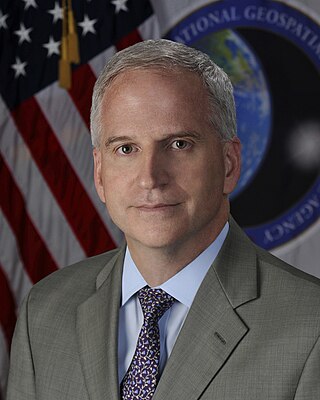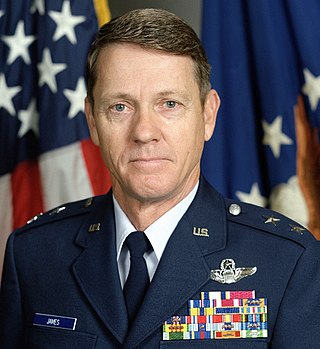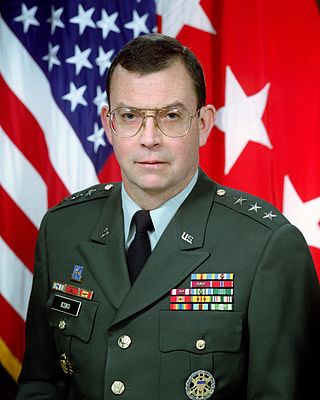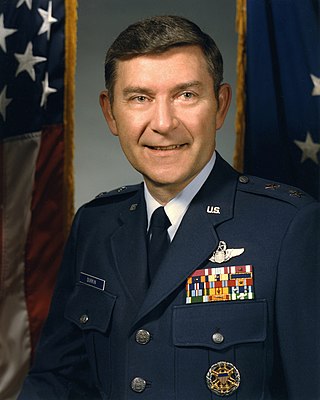
The National Geospatial-Intelligence Agency (NGA) is a combat support agency within the United States Department of Defense whose primary mission is collecting, analyzing, and distributing geospatial intelligence (GEOINT) in support of national security. Initially known as the National Imagery and Mapping Agency (NIMA) from 1996 to 2003, it is a member of the United States Intelligence Community.

The United States Naval Criminal Investigative Service (NCIS) is the primary law enforcement agency of the U.S. Department of the Navy. Its primary function is to investigate criminal activities involving the Navy and Marine Corps, though its broad mandate includes national security, counterintelligence, counterterrorism, cyberwarfare, and the protection of U.S. naval assets worldwide. NCIS is the successor organization to the former Naval Investigative Service (NIS), which was established by the Office of Naval Intelligence after the Second World War.

James Arthur Williams was a United States Army lieutenant general. Williams served as Director of the Defense Intelligence Agency in the 1980s. He was a 1987 inductee of the Military Intelligence Hall of Fame and was the chairman of the board of directors for the National Military Intelligence Association.

Harry Edward Soyster is a retired United States Army Lieutenant General.

Lieutenant General Tome H. Walters Jr. was Director, Defense Security Cooperation Agency, Office of the Secretary of Defense, Arlington, Virginia. The agency directs and oversees U.S. foreign military sales, foreign military financing programs, international military education and training programs, and humanitarian assistance and demining programs.

General William Gilbert Townsend Tuttle Jr. was a United States Army four-star general who served as Commanding General, United States Army Materiel Command from 1989 to 1992.

Robert Cardillo is a Distinguished Fellow at Georgetown University’s Center for Security and Emerging Technology. Prior to this appointment, he was the sixth Director of the National Geospatial-Intelligence Agency and was sworn in October 3, 2014. He was previously selected by Director of National Intelligence James Clapper to serve as the first Deputy Director of National Intelligence for Intelligence Integration in September 2010. Clapper said in a statement that the position would "elevate information sharing and collaboration" between those who collect intelligence and those who analyze it. Cardillo previously served as Deputy Director of the Defense Intelligence Agency (DIA). Prior to that, he served as the Deputy Director for Analysis, DIA, and Director, Analysis and Production, National Geospatial-Intelligence Agency (NGA).

The Army Map Service (AMS) was the military cartographic agency of the United States Department of Defense from 1941 to 1968, subordinated to the United States Army Corps of Engineers. On September 1, 1968, the AMS was redesignated the U.S. Army Topographic Command (USATC) and continued as an independent organization until January 1, 1972, when it was merged into the new Defense Mapping Agency (DMA) and redesignated as the DMA Topographic Center (DMATC). On October 1, 1996, DMA was folded into the National Imagery and Mapping Agency (NIMA), which was redesignated as the National Geospatial-Intelligence Agency (NGA) in 2003.

William Lloyd Nicholson III was an American Air Force major general. As his last assignment, he was director of the Defense Mapping Agency from July 1979 – June 1981.

Major General William K. James of United States Air Force, was director of the Defense Mapping Agency (DMA) between June 1990 and June 1993. Under his leadership Major General James redirected the DMA – a heritage organization of the National Geospatial-Intelligence Agency – from producing products to meet the requirements of the Cold War to a concept of a Global Geospatial Information System (GGIS) directly accessible to combat commanders of the Rapid Deployment Forces. The GGIS was a major paradigm shift in warfare with the delivery of geographic information to fast-moving military forces.

Rutledge Parker "Hap" Hazzard was director of Science and Technology division of Central Intelligence Agency (CIA) from 1973 to 1978. He became director of the National Photographic Interpretation Center (NPIC) in 1978. After serving six years as director of NPIC from June 1978 to February 1984, Hazzard returned to the CIA's National Intelligence Office. He retired from public service in 1985.

Major General Philip William Nuber of United States Air Force, was director of the Defense Mapping Agency from December 1994 to May 1996.

James C. King is a retired United States Army Lieutenant General. A career Military Intelligence officer, he served on active duty from 1968 to 2001. At the time of his retirement he was serving as the Director of the National Imagery and Mapping Agency, one of the intelligence agencies of the United States Intelligence Community.

Shannon D. Cramer Jr. was a United States Navy vice sdmiral. He was second director of the Defense Mapping Agency from September 1974 to August 1977. From April to September 1974, he was deputy director for plans, Defense Intelligence Agency.

Lieutenant General Abner Broadwater Martin was third Director of the United States Defense Mapping Agency from September 1977 to June 1979.

Major General Raymund E. O'Mara of United States Air Force, was tenth Director of the Defense Mapping Agency from June 1993 till his retirement in December 1994; with headquarters at Fairfax, Virginia. As director of DMA, O'Mara moved forward with the implementation of the Global Geospatial Information System, and also initiated the agency's reinvention task force.

Rear Admiral Edward Anderson Wilkinson Jr. of United States Navy was the Director Defense Mapping Agency from July 1983 to July 1985. He was also the deputy director of Defense Mapping Agency from July 1979 to May 1981.

Major General Robert Alan "Rosie" Rosenberg of United States Air Force was Director of Defense Mapping Agency from July 1985 to September 1987. Throughout his 30-year career with the U.S. Air Force, he was instrumental to the U.S. satellite program. National Geospatial-Intelligence Agency inducted him into its Hall of Fame in 2005.

Major General Robert Francis Durkin of the United States Air Force was Director of Defense Mapping Agency from October 1987 to June 1990. As director, Durkin restructured the Defense Mapping Agency's international and domestic training in the production and exploitation of geospatial information.

Melbourne Kimsey is a retired brigadier general in the United States Air Force who served as director of the Cheyenne Mountain Complex from 1981 to 1983,




















